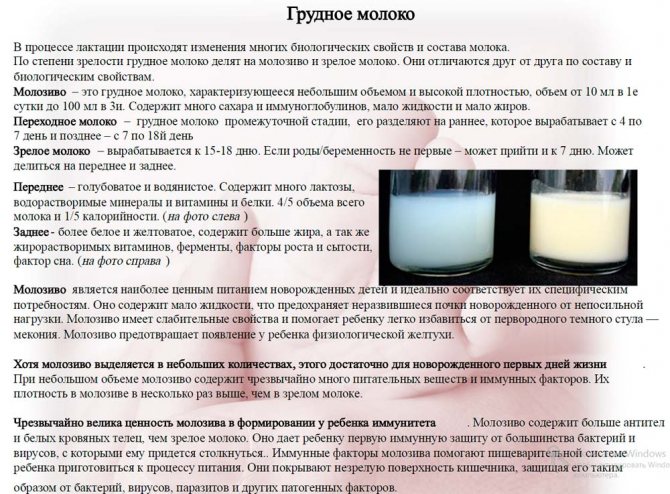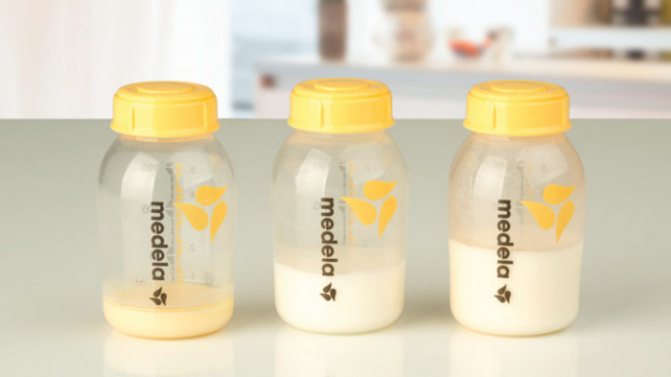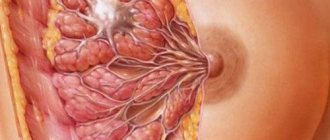What does it look like
This substance is formed in the breast before childbirth and continues to be released in the first 3-5 days after, until transitional milk appears to replace it. Early colostrum can appear at any stage of pregnancy. Long before delivery, a small amount of yellow or whitish, translucent colostrum is sometimes released from the breast. This is considered a normal variant if it is not accompanied by pain and is not stained with blood.
To find out what colostrum looks like, just press on the nipple immediately after birth (this cannot be done before giving birth, so as not to stimulate the uterus earlier than expected). A thick substance will be released; it tastes salty and differs from milk. The color of colostrum is usually yellowish.
Composition of colostrum and its nutritional value
The calorie content of 100 g of colostrum on the first day after birth is approximately 150 kcal. It contains about 6 g of proteins (albumin, globulin, lactoferrin), about 8 g of fats in the form of small, easily digestible balls and about 14 g of carbohydrates, represented mainly by lactose. Over time, the calorie content gradually decreases and by the fifth day it drops to 70 kcal per 100 g. At about the same time, the volumes also decrease; for 4-5 days, instead of colostrum (the Latin version of the name for colostrum), first a transitional substance appears, mixed with colostrum, and then and complete mature breast milk.
Considering the micronutrient composition of nutritious maternal secretions, it should be noted that it is much richer and more diverse than the composition of milk and includes:
- bifidobacteria and lactobacilli;
- vitamins of groups A, B, C, E and PP;
- mineral salts;
- natural antioxidants (zinc, selenium);
- leukocytes;
- hormones;
- food enzymes, in particular lipase, amylase and protease;
- water.
The percentage of the above components may vary slightly depending on the individual characteristics and diet of the woman.
Composition and functions
Before birth, the child fed, receiving already broken down beneficial substances from the mother’s blood and the placenta. His stomach and intestines are sterile. But immediately after birth, the type of nutrition changes dramatically. The composition of colostrum, similar to human blood, is designed to solve several problems at once:
- Protect the child from an aggressive microbiological environment. From the complete purity of the uterus, immediately after birth he is attacked by bacteria, viruses and other microorganisms. To prevent pathogens from having a detrimental effect on the little person, the mother supplies immunoglobulins and other living immune cells of various types. Some enter the blood, others line the mucous membrane of the child’s intestines, nasopharynx, and respiratory organs.
- Colonize the digestive tract with bacteria. Their benefits are in the formation of one’s own immunity, assistance in the digestion of new food and the synthesis of substances necessary for the body.
- Give energy for life, growth and development. The beneficial properties of colostrum are such that with a smaller amount of food (after all, the stomach is not yet ready to work at full capacity), the baby receives the maximum benefit. There are still a few fats and carbohydrates, because they will not be fully digested. But there is enough protein, since the baby grows very quickly and gains weight.
- Provide the body with vitamins and minerals for organ development. Colostrum is yellow due to its high carotene content. These factors contribute to the development of vision. And a large amount of zinc promotes rapid brain growth. After all, the first task of a baby is to see and recognize the mother as the source of his nutrition.
- Adapt to a new life. The appearance of colostrum provides the newborn’s stomach and intestines with a painless transition from the previous type of nutrition to a new one. The chemical composition of the substance is similar to both blood and amniotic fluid, which he was accustomed to swallowing during pregnancy in the womb. At the same time, such nutrition protects the kidneys, which are not yet ready for the load: it contains a lot of calories, but little fluid. So gradually the organs become accustomed to milk.
- Discard meconium. Even in the prenatal period, the child’s intestines are filled with original feces, in which the products of the liver – bilirubin – have accumulated. It is important to remove it quickly, so colostrum has a laxative effect. Helps cope with newborn jaundice.

VALUE OF COLOSTRUM. HOW IT ALL STARTS.
Colostrum appears in the breast even before birth and should serve as the baby’s first food in a new world. Researchers studying the composition of colostrum admiringly call it a magic elixir - but mothers themselves often underestimate it. Let's talk about what is so magical about colostrum, and why it is so important for a child to receive colostrum in the first days of life. The value of colostrum The orange or bright yellow color of colostrum is explained by the fact that, unlike mature milk, it is very rich in leukocytes and other anti-infective proteins. Leukocytes are protective white cells that destroy pathogenic bacteria and viruses. All anti-infective proteins provide the first immunization against diseases that the baby may encounter after birth. Thus, colostrum is saturated with antibodies called immunoglobulin A. It protects the weakest places in the body, where infections are easiest to penetrate - the mucous membranes of the throat, lungs and gastrointestinal tract. Therefore, experts compare colostrum with medicine - during the first application of the baby to the breast immediately after birth, the baby sucks out about a teaspoon of colostrum, but this is enough to reduce the risk of developing bacterial infections. Many components of colostrum help further growth and adaptation of the baby’s body. Thus, beta-casein7 affects the functions of the central nervous system, helps to develop intelligence, emotions, and general mental development. Special nerve growth substances promote the development of the peripheral and central nervous systems. The growth factor in colostrum promotes the development of the baby's immature intestines after birth. Colostrum protects the baby from developing allergies and intolerance to other foods. Oligosaccharides (also known as prebiotics), of which there are more than 130 types in colostrum, protect the baby from intestinal infections. Prebiotics nourish healthy intestinal flora. Two of these 130 oligosaccharides are added today to infant formulas in order to bring them at least a little closer in composition to mother’s milk. And a colostrum component such as lactoferrin helps the baby absorb iron without being a breeding ground for harmful intestinal flora - which is artificially added iron in the mixture. In terms of the content of some vitamins, colostrum is much richer than mature milk: in particular, vitamin A, which reduces the severity of any infections in the child, and vitamin E, which promotes the development of the nervous system, muscle tissue and retina. In addition, colostrum also has a mild laxative effect, which cleanses the baby’s intestines of meconium (primary dark-colored stool). This is why babies fed colostrum poop much more often than they pee in the first days of their lives. At the same time, the child’s intestines are cleared of excess bilirubin, which prevents the development of pathological jaundice. At the same time, colostrum is very concentrated and much more nutritious compared to mature milk. On the first day of a child’s life, the protein content in colostrum reaches 14% - this is about three times more than in mature milk. The amount of colostrum may vary, but in any case, due to its increased nutritional value, it is enough for a newly born baby. There is very little water in colostrum, and this is good, because the baby is not yet able to process large volumes of liquid: his kidneys are not able to undergo immediate adaptation from the prenatal period. At the same time, the child is already born with a supply of water, which protects his body from dehydration until mature milk rich in liquid arrives. How it all begins If the mother has the opportunity, then it is best to attach the baby to the breast 15-30 minutes after birth and let her nurse longer (about 20 minutes on each breast). It is during this period that the baby comes to his senses a little after childbirth and begins to display searching behavior - looking for his mother’s breast. He tries to raise his head, opens his mouth, sticks out his tongue. Sometimes the baby lying on the mother’s belly begins to literally crawl towards the breast! However, you should not expect miracles from nature - a healthy newborn can indeed reach the mother’s breast, but this costs him a lot of effort and all the strength remaining after childbirth, so, of course, it is better to help him get what he wants. If this moment is missed, the baby will fall asleep and then no amount of persuasion can be applied to his mother’s breast - he will rest. The baby's sucking reflex is especially strong in the first hour after birth, and this helps develop proper attachment to the breast. It is correct attachment that should be given the main attention in the first days of life. Correct attachment can be briefly described as follows: the mother presses the baby tightly with her tummy so that the nipple points to his nose. The chest must be supported with your hand so that the thumb is on top, where the baby’s nose is, and the index finger and the rest are on the bottom, parallel to the baby’s lower lip. The index finger should be far from the nipple, no closer than 5 centimeters, so as not to limit the opening of the baby’s mouth. Wait until the child opens his mouth wide, as if he were yawning. At this moment, press the baby even closer to you, pointing the nipple at the top of the mouth: the nipple and areola will be deep in his mouth, more from below than from above. The lower and upper lips turn outward when sucking. Most often, on the first day after childbirth, the breasts are soft to the touch and seem empty. Very little colostrum is released, although in some women it may slowly flow out of the breast on its own, while others, on the contrary, have difficulty squeezing out a single drop. This still does not say anything about the actual amount of colostrum and, especially, milk in the future - it all depends only on the individual characteristics of the structure of the breast. The babies themselves behave differently: most sleep off, recovering from childbirth, and latch onto their mother’s breasts only 5-7 times a day, but for a long time, sometimes up to an hour. But some, on the contrary, from the first day of life ask for their mother’s breast very often. There is another interesting pattern: on the second or third day of life, provided they are together with their mother, even calm and rarely suckling babies suddenly begin to demand a kiss literally every half hour. This means that the baby has already matured to receive food more plentiful than colostrum - and thanks to more frequent breastfeeding and changed movements of the mouth, the mother begins to produce milk. And it is at this moment that young mothers are often afraid that the baby is “starving”, and they run for formula, trying to feed at least something, so that the child - which the mother herself tears off from the breast in such cases - does not cry. But is it worth doing this if the mother has the opportunity to put the baby to the breast? So is supplementary feeding necessary? Indeed, a baby who has eaten formula usually falls asleep for several hours, but this happens not just because he is full, but because the formula is much harder to digest than breast milk. A child’s body simply does not have enough strength for anything other than sleep. And, of course, the mother’s milk supply is inevitably delayed. What kind of food a newborn baby receives has a direct impact on the development of intestinal microflora. Breastfeeding women have a lower acidic environment in the intestines - approximately 5.1-5.4 pH during the first six weeks, represented mainly by bifidobacteria with a small amount of pathogenic flora. And babies fed exclusively with formula have an acidity of approximately 5.9-7.3 pH with a variety of putrefactive bacterial flora. That is why children who are fed formula are much more likely to suffer from intestinal infections and various forms of allergies. Unfortunately, in families where there is a high risk of developing allergies due to heredity, even after one feeding with formula instead of colostrum, sensitivity to cow's milk protein can develop. In breastfed children, when supplemented with formula, the acidity is average - 5.7-6.0 pH during the first four weeks, by one and a half months it decreases to 5.45 pH. Unfortunately, the intestinal flora under such conditions develops very similar to that which occurs when feeding with formula - very unstable, with a predominance of pathogenic ones. Even one feeding of formula per day, but regular, quickly leads to the development of an imbalance of the intestinal flora - the number of enterobacteria and enterococci quickly increases, the number of clostridia and anaerobic streptococci increases. This is the same phenomenon that is usually called dysbiosis. If in the future the mother continues to exclusively breastfeed, it will take two to four weeks to return to a state that supports positive flora in the intestines. In addition to disrupting the formation of normal intestinal flora, supplementary feeding with formula during the period when the baby should still receive colostrum increases the likelihood of difficulties with the breast (the occurrence of cracks and stagnation of milk against the background of not entirely correct latching). And statistical studies by both foreign and Russian doctors have shown that mothers whose children were supplemented with formula in the first days of life usually stopped breastfeeding earlier than if the child had been exclusively breastfed from birth. At the same time, there are, of course, cases when supplementary feeding with formula is objectively necessary - it is prescribed by a doctor, and, as a rule, this is due to the serious condition of either the mother herself or the baby. But if there are no strict indications for the introduction of supplementary feeding with formula, a new mother needs to understand what exactly she is risking when she goes to the nursery to ask for “just one bottle of formula.” Scales and diapers And yet the fear that the child is malnourished often haunts mothers who have recently given birth. And here it is important, first of all, to calm down yourself and think that nature could not have counted on inventing the mixture. If there really wasn’t enough colostrum for the baby, then humanity simply wouldn’t survive as a species. There are also clear guidelines that a mother can rely on to make sure that everything is okay with her baby. Weight loss, which doctors will definitely tell you about, is common to all children on the third or fourth day of life. By this time, the baby gets rid of meconium - the original stool that accumulated while still in the womb, and from moisture reserves that were supposed to help pass through the birth canal without injuring the baby’s skin. If the weight loss is within 5-8% of birth weight, then this is normal, and such loss is called physiological. For comparison, with a newborn baby weighing 3500 g, it is quite normal if on the third or fourth day of life he loses 175-280 g. But with a greater loss, the doctor may already prescribe supplementary feeding. To know for sure that the baby receives as much nutrition as he needs in the first days of life, you can count the number of wet diapers. Until the child is one week old, with sufficient nutrition, he will pee as many times as he is days old, sometimes one more time. So, a baby of two days old, if his nutritional needs are satisfied, will pee 2-3 times, at three days old - 3-4 times, and so on. If the baby still needs supplementary feeding, it is better to give it not from a bottle, but from a spoon, a small cup or a special system for supplementary feeding at the breast. All this reduces the likelihood of problems with the child’s further behavior under the breast. When breastfeeding is successful, the World Health Organization and, following it, the latest recommendations of the Ministry of Health and Social Development call the following indicators that breastfeeding will be successful:
- mother and baby have skin-to-skin contact immediately after birth and the baby begins to breastfeed within an hour or so after birth. This stimulates milk production in the mother, and the baby receives the colostrum he needs in a timely manner.
- The baby is properly attached to the chest and is feeding efficiently, with slow, deep sucking movements.
- The baby can breastfeed whenever he wants, day or night, and is not limited in the duration of feeding. This is ensured by the mother and child staying together in the “Mother and Child” ward.
- The baby does not suck on artificial nipples, which make him less interested in breastfeeding. If there is a need for supplementary feeding, it is given in alternative ways to the bottle.
Irina Ryukhova, member of the Association of Breastfeeding Consultants, based on materials from the AKEV website.
You can consult by calling our breastfeeding hotline (daily from 7.00 to 23.00).
Previous
Next
During pregnancy
Moderate release of colostrum from the nipples even before birth at any stage of pregnancy is normal. The mother's body is just training, preparing for the birth of a child. It is formed under the influence of hormones immediately after conception and can appear from the mammary glands when pressed. But you shouldn’t experiment with this, because... Stimulation of the nipples by the type of latching by the baby causes the mother's body to release hormones that are simultaneously responsible for the contraction of the uterus.
If you haven't noticed these white or yellowish spots throughout your pregnancy, don't worry, this is normal. Although in some cases it appears before birth, most often it begins to be released on its own immediately after the baby is born.
Colostrum
Colostrum differs from milk not only in composition, but also in the concentration of components. It is a yellowish and fairly viscous liquid with a high protein content. Due to the small size of the stomach of a newborn baby, even a small amount of this liquid is enough to fully satisfy its nutritional needs.
Character traits:
- The high content of finely dispersed protein ensures easy digestibility and no stress on the digestive tract and intestines.
- The composition contains beta-carotene, which gives the liquid a yellowish color. The presence of this substance has a positive effect on the development of the baby’s immune system, improving the body’s protective function.
- The lack of water is justified by the fact that after birth the necessary amount of liquid is already present in the baby’s body and is enough before feeding with mature milk. Large volumes of fluid can place a serious strain on an infant's unprepared kidneys.
- HAMLET is a complex contained in breast milk that provides prevention against various cancers. A similar effect is achieved only with full breastfeeding.
- Rich in immunoglobulin A, which in the first days of a child’s life provides protection to the mucous membranes and walls of the gastrointestinal tract. The content of immunoglobulin A is so high that it is 50 times higher than the dosage of the substance used to treat disorders of the immune system in adults.
- Promotes the rapid release of bilirubin from the baby’s body due to its laxative effect.
Colostrum is an important part of breastfeeding. Having received this liquid immediately after birth, the child more easily adapts to his new environment due to the strengthening of the body’s protective function.

Hygiene rules and feeding regime
It is important to feed your baby colostrum in the first hour of life. This starts the process of its additional secretion and the establishment of subsequent lactation. The milk will come only in a few days, and inexperienced mothers sometimes worry whether the baby is hungry. You should not express colostrum to check for its presence if the baby is close to the mother, has full access to the breast and is actively sucking. Just out of curiosity, you can’t squeeze out colostrum, because there’s not much of it, and everything should go to the baby.
Pumping is indicated in the following cases:
- The newborn is weakened and is under observation. He will not be able to suckle on his own; he must be fed colostrum from a bottle.
- The woman in labor received medications that were harmful to the baby. It's better to decant and discard.
- Rhesus conflict is possible. Colostrum should not be given to a child until the child’s blood type and Rh factor have been determined and a doctor’s opinion has been obtained. If a conflict arises, you should pump regularly to maintain lactation until the pediatrician allows you to start breastfeeding.
- There was a long break between feedings. It's better to express the portion. Colostrum is not stored, so it is useless to freeze it: the main – protective – function will be lost after thawing.
In order for the release of colostrum (and subsequently milk) to be regular and sufficient, you must follow the rules of breast care:
- Wear a special bra made from natural fabrics, selected according to size.
- Wash your breasts once a day, not before each application.
- If cracks occur, apply only special ointments recommended by pediatricians.
How to store colostrum
Express the food with a gentle pulling pressure along the breast, then lightly press on the nipple. For storage use:
- glass containers;
- Ziploc bags for breast milk;
- plastic cups for pumping;
- sterile test jars;
- baby food jars.
Depending on the duration of storage, the food can be left in a cool room, placed on a shelf in the refrigerator, or placed in the freezer.

| Expressed colostrum | Room t up to 25-27◦ | Refrigerator (up to +5◦C) | Freezer |
| Fresh, sterile packed | Up to 6-7 hours | Up to 3 days on the top shelf | General chamber (-15◦) – 14 days; Separate chamber (-18◦) - up to 3 months; Deep freezing (-20◦) – six months to a year |
| Thawed in the refrigerator | No more than 4 hours | day | Do not freeze again |
| Defrost at room temperature | Fed immediately | 3-4 hours | Do not freeze again |
If the child has eaten expressed milk, the leftovers cannot be stored even in the freezer. It is not advisable to constantly use expressed product for feeding. No, colostrum will not be lost; its immune strength and nutritional value will decrease.
- Related Posts
- Colostrum with blood after childbirth: what to do?
- Why colostrum is released without pregnancy and how to stop it
- What to do if you don't have enough colostrum
« Previous entry
How much should there be
Feeding your newborn colostrum is very important. The benefit is mutual: the baby receives invaluable drops and learns to digest food, the mother’s uterus contracts, and during these short periods of sucking the breast prepares for full feeding. After all, breastfeeding will place a significant strain on the delicate skin of the nipples, soreness and cracks are possible. This short-term training is needed to adapt to the next period.
It is difficult for a woman to independently determine whether her baby has enough colostrum or not. Moreover, during this period, colostrum does not flow from the breasts, like milk in the very first days of the establishment of lactation, the breasts do not swell every 3 hours.
It is believed that a newborn eats up this amount of food if he sleeps a lot, does not cry, and often empties his intestines. In addition, in the first days of life, he is not yet able to suck for a long time; he needs to regain strength after childbirth.
What it is
Lactation in a woman who has given birth begins with the appearance of colostrum in the mammary glands. The nutritious secretion is a precursor to mature milk. Preparation for the production of colostrum begins during pregnancy with hormonal changes.
Two hormones are responsible for the process and for lactation in general - prolactin and oxytocin. Their action is interdependent.
- Prolactin. In the later stages, it is synthesized by the anterior lobes of the pituitary gland. It is this hormone that leads to the formation of colostrum in the mammary glands. With the first application of the baby to the breast, the synthesis of prolactin increases sharply and, in a chain reaction, the production of first colostrum and then milk increases.
- Oxytocin. He has an equally important role. Relaxation of the ducts of the mammary glands and the outflow of colostrum occurs thanks to this hormone. It begins to work in the body of a pregnant woman from the first days of bearing a child. The production of oxytocin directly depends on the emotional state of a woman.
The peak content of prolactin in the body of a nursing mother occurs in the morning and night hours. So colostrum is most abundant during this period.
When will it change to milk?
After colostrum (3-5 days after birth), the so-called transitional milk comes. It is necessary as another step, preparing the child’s gastrointestinal tract for the subsequent work - digesting mature maternal nutrition.
The composition of milk and colostrum is different. The amount of lactose and fat increases, the composition of proteins changes, enzymes, hormones are added, fewer immune factors and more substances for better digestion of food. Protection against the first introduction of microorganisms from the outside has already been solved; now it is important to grow quickly.
It is not difficult to distinguish colostrum from milk by appearance: the first is thick, viscous and yellowish, the second is white, more liquid and appears to be diluted with water. Milk, unlike its predecessor, flows noticeably, generously released from the mammary glands at the slightest stimulation: the sight of a child, his cry, latching on the nipple. Hot flashes are not typical for colostrum.

Composition of colostrum
The nutrient density of this thick liquid is many times higher than that of breast milk. Most of all, it contains proteins - albumins and globulins, as well as natural antioxidants - vitamins A, E, beta-carotene, zinc and selenium. At the same time, colostrum contains very little casein and lactose - substances that can irritate even the adult intestines. Colostrum also contains immunoglobulin A, lactoferrin, living leukocytes-macrophages, oligosaccharides and polysaccharides, neutrophils and T-lymphocytes. All these biologically active elements are not digested, but accumulate in the intestines and cover its immature surface. This way he becomes protected from pathogenic bacteria, leukocytes gradually produce interferon, and the baby develops immunity against viral infections.
Biologists have long studied colostrum and confirm that its resistance against E. coli, streptococcus, salmonella, rotavirus, Coxsackie virus, polio, enteroviruses, encephalitis virus, herpes and Candida fungi is very high. And thanks to hormones such as insulin, cortisol, peptides and epidermal growth factor, also contained in colostrum and also in large quantities, the newborn grows rapidly, and its bone tissue, along with brain cells, quickly develops.
If there is no colostrum
Sometimes it seems to the mother that the colostrum has disappeared or was not there to begin with. Most often this turns out to be an illusion, because it may not appear from the nipples at all, even with pressure. And you cannot determine its presence on your own. The only indicator will be the condition of the child. Doesn't worry, soils diapers, sleeps peacefully - everything is fine.
If the birth was difficult, surgical intervention, premature or emergency, then there may be problems with the formation of colostrum in the glands. This is due to the body’s unpreparedness for childbirth itself and for the launch of hormonal support for breastfeeding. The following tips will help you start the necessary process or increase its intensity:
- It is important for the mother in labor to rest and regain strength.
- There should be enough liquid. Clean water is best.
- If possible, the child should always be nearby. Applying to the breast as soon as required is the key to establishing proper lactation.
But the most important thing in the process of establishing feeding is the calmness and balance of the mother. When she does not experience anxiety, nothing distracts her from the child, nature will do everything right itself.










